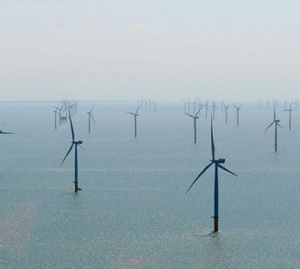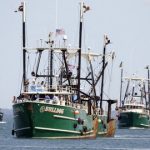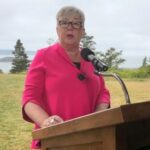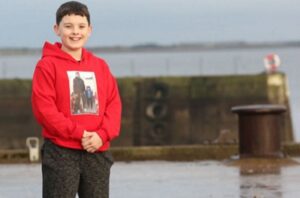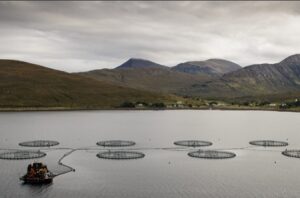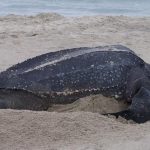Tag Archives: Offshore wind developers
Bam! Scientists study wind farm construction noise impacts on lobsters… by making big noises
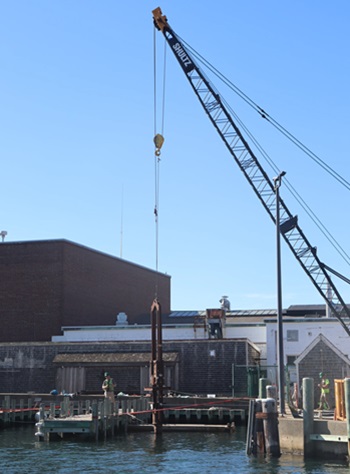 Thirteen feet below the surface of Woods Hole harbor, a lobster shelters under a plastic shield in a wire cage. An experiment is happening: every seven seconds on the dock above, a pile driver pounds a long, steel post deeper into the muddy harbor bottom nearby. The experiment happening here at this dock is designed to replicate, at small scale, the pile driving necessary to construct an offshore wind farm. The goal is to understand how a variety of marine creatures, not only lobsters, but other fish-market-friendly species like scallops, flounder, black sea bass, and squid respond to the noisy, intensive work of building an offshore wind farm. It’s something fishers and regulators are especially interested in. Already, the WHOI team’s earlier studies have shown that squid, which detect sound through vibration, responded dramatically to pile-driving noise — at least, at first. But it’s a different story for scallops, one of the highest value fisheries in the U.S. As soon as scallops were exposed to pile driving noise, they clammed up. Photos, more, >>CLICK TO READ<< 07:59
Thirteen feet below the surface of Woods Hole harbor, a lobster shelters under a plastic shield in a wire cage. An experiment is happening: every seven seconds on the dock above, a pile driver pounds a long, steel post deeper into the muddy harbor bottom nearby. The experiment happening here at this dock is designed to replicate, at small scale, the pile driving necessary to construct an offshore wind farm. The goal is to understand how a variety of marine creatures, not only lobsters, but other fish-market-friendly species like scallops, flounder, black sea bass, and squid respond to the noisy, intensive work of building an offshore wind farm. It’s something fishers and regulators are especially interested in. Already, the WHOI team’s earlier studies have shown that squid, which detect sound through vibration, responded dramatically to pile-driving noise — at least, at first. But it’s a different story for scallops, one of the highest value fisheries in the U.S. As soon as scallops were exposed to pile driving noise, they clammed up. Photos, more, >>CLICK TO READ<< 07:59
Right whales and offshore wind: reflections on an uneasy coexistence
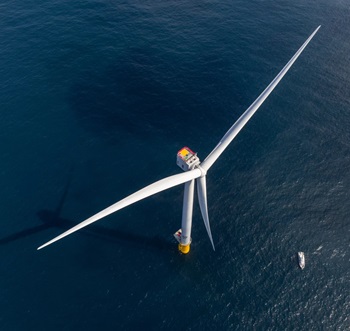 Michael Moore has spent decades studying North Atlantic right whales. He’s seen somewhere around 150 of them. It’s a feat, given that now there are just about 360 left in the world. But the veterinarian, author, and scientist emeritus from the Woods Hole Oceanographic Institution had never seen an offshore wind farm up close — until last week. “Look at them. All out in neat little rows,” he said, standing at the rear of a 53-foot charter boat that offered a closeup view of construction on Vineyard Wind, 15 miles south of Martha’s Vineyard. About half of the planned 62 turbines are fully constructed, reaching more than 250 meters into the sky. When the boat slowed down to pass beneath one of the turbines, Moore was awestruck by the length of a blade. “Right whales are 40 to 50 feet,” he said. “So, you can stretch seven right whales along the length of one of these blades.” Photos, more, >>CLICK TO READ<< 16:48
Michael Moore has spent decades studying North Atlantic right whales. He’s seen somewhere around 150 of them. It’s a feat, given that now there are just about 360 left in the world. But the veterinarian, author, and scientist emeritus from the Woods Hole Oceanographic Institution had never seen an offshore wind farm up close — until last week. “Look at them. All out in neat little rows,” he said, standing at the rear of a 53-foot charter boat that offered a closeup view of construction on Vineyard Wind, 15 miles south of Martha’s Vineyard. About half of the planned 62 turbines are fully constructed, reaching more than 250 meters into the sky. When the boat slowed down to pass beneath one of the turbines, Moore was awestruck by the length of a blade. “Right whales are 40 to 50 feet,” he said. “So, you can stretch seven right whales along the length of one of these blades.” Photos, more, >>CLICK TO READ<< 16:48
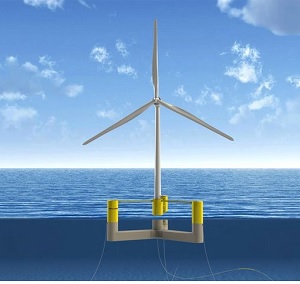
Old lumber port preps for new life as California offshore wind hub
Eureka’s halcyon days as the “timber capital” of California are long gone, but the deepwater port city 270 miles north of San Francisco may see its fortunes turn as the hub of the state’s first foray in offshore wind energy. Eureka sits across two of the five swaths of Pacific Ocean along the California coast that the federal government auctioned off to offshore wind developers this past December for a total of $757 million. The three other leases are on the Central Coast across from Morro Bay. Humboldt Bay, the second-largest bay in California after the San Francisco Bay, is ideally suited to become the final assembly port for the massive turbines. >click to read< 15:43
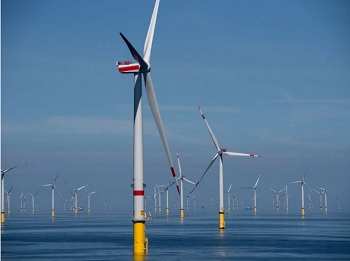
Proposed bill would make offshore wind developers create compensation fund
The fund would provide compensation if construction or operation of a facility damages fisheries or the marine environment, and if the developer creates fewer jobs than promised in an agreement. Sen. Heather Somers, R-Groton, co-introduced House Bill 5223 with four Democratic state representatives, while three Republicans and two Democrats are co-sponsors. “This is new territory,” Somers said. “It’s an industrialization underneath the ocean that we have not seen before, and we do not have the data.” Somers’ district has the last commercial fishing fleet in the state, in Stonington, and she said “if the impact is such that they can no longer fish or their career is not viable, it was important for us on the committee to not prioritize one industry over another.” >click to read< 08:02
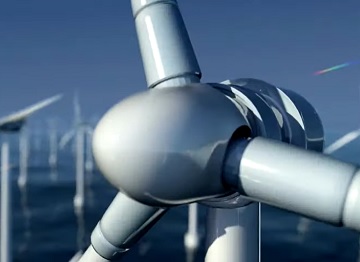
Offshore Wind: No measurable influence on climate change
Officially, offshore wind developers anticipate their projects will “have no measurable influence on climate change.” Knowing this, they offer a different rationale. In the “purpose and need” section of the draft environmental impact statement for Revolution Wind, Ørsted justifies the offshore wind project based on its ability to fulfill Rhode Island’s mandate for “renewable” energy. Meeting a political mandate differs rather significantly from combating climate change. Ørsted seems to understand this difference, but the public may not. No environmentally conscious individual wants to hear such depressing facts, including us. Despite numerous articles from pro-wind enthusiasts touting the promise of offshore wind, the carbon savings of these projects fail to justify their construction. >click to read this< 18:34

SPECIAL REPORT: Winds of change Part II – Windfalls! With more windfalls to come!
Energy efficiency projects and third level scholarships, sports clubs, active retired groups and local festivals were just some of those to benefit from almost €3.5m dished out by the developers of Irish windfarms in 2019.,,, One local firm that sees the danger of alienating the fishing industry is Green Rebel Marine, the Cork-based business established to service the future needs of offshore wind farms. In January it announced what it called ‘a new strategic partnership’ with a company, formerly based in Cobh, but which will now be working out of Green Rebel Marine’s offices in Crosshaven, called Fisheries Liaisons Ltd. Fisheries Liaisons staff will negotiate with fishing interests on Green Rebel Marine’s behalf, thereby smoothing the way for developers who are planning offshore windfarms. >click to read< 13:22
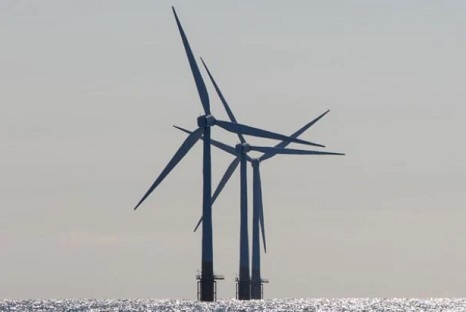
SPECIAL REPORT: Winds of change – Developers grease the skids to ingratiate themselves and minimize negative reception
Rural onshore windfarms have long been a subject of much debate, Windfarm developers have found that their financial contributions to local communities, like sports clubs, local organizations and projects, have helped to ingratiate themselves with the locals and minimize negative reception. HUH! Between these generous handouts and potential legal challenges, many developers of windfarms have found the projects an expensive business. But now the sector has spotted another option on the horizon – literally. Offshore wind farms. The biggest criticism of the offshore wind 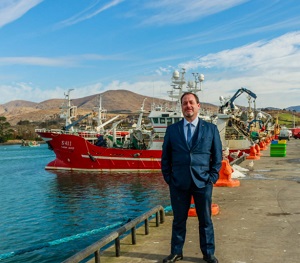 energy sector in Ireland so far has come from fishing interests, Patrick Murphy of the Irish South & West Fish Producers Organisation told Southern Star recently that the commandeering of sites at sea by windfarm developers today is akin to the land grabs from the native Americans in the 19th century. >click to read< 12:59
energy sector in Ireland so far has come from fishing interests, Patrick Murphy of the Irish South & West Fish Producers Organisation told Southern Star recently that the commandeering of sites at sea by windfarm developers today is akin to the land grabs from the native Americans in the 19th century. >click to read< 12:59

This Blows! Fishing industry raps proposed wind energy grid
“The proposed layout specifies that turbines will be spaced 1 nautical mile (nm) apart, arranged in east-west rows and north-south columns, with the rows and columns continuous across all New England lease areas.” But the claim that the newly proposed layout would satisfy the requests of the fishing industry did not entirely hold up once the developers’ plan was released publicly Tuesday morning. An organization that advocates on behalf of the scallop industry said its members were not consulted,,, >click to read< 19:41
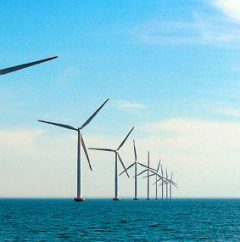
Offshore wind developers court recreational fishing community
Offshore wind energy developers are courting recreational fishermen in the New York Bight, who could gain dozens of new fishing spots around turbine towers, but worry about impacts of the massive projects on traditional fishing grounds. “Obviously the hot button for us is access,” said charter captain Paul Eidman of Anglers for Offshore Wind Power, a project of the National Wildlife Federation, which hosted the meeting in Toms River, N.J., on Wednesday along with the American Littoral Society for offshore wind companies and recreational fishermen. >click to read<09:31:04

Offshore wind developers ante up at auction of leases near Block Island
In what is sure to be seen as an affirmation of their industry’s prospects, a scrum of offshore wind developers is poised to pay an unprecedented amount of money for the latest set of leases being auctioned off in federal ocean waters near Rhode Island and Massachusetts. When the federal Bureau of Ocean Energy Management suspended its auction Thursday night for the three leases located in waters about 51 miles southeast of Block Island, the bids for each had reached between $91 million and $101 million — more than twice the highest amount paid in the past for an offshore wind lease in the United States and a range that compares favorably to payments for oil and gas projects. The bureau, part of the U.S. Department of the Interior, described the day as “historic.” In a tweet, Interior Secretary Ryan Zinke said, “We have something big going on off the coast of Massachusetts.” >click to read<10:13

SMAST meeting brings fishing, offshore wind in the same room
Offshore wind developers spent the majority of a 3-hour meeting Monday attempting to win over the local commercial fishing industry. For much of he meeting, the fishermen in attendance rolled their eyes, scoffed at various PowerPoint slides and even went as far as to say offshore wind is unwanted. “Nobody wanted this,” one fisherman out of Point Judith said. “Nobody wanted problems. We are assured there would be none. And here we are.” Twenty members of the Fisheries Working Group on Offshore Wind Energy sat around a table at SMAST East hoping to solve various issues between the two ocean-based industries. >click to read< 18:09 
Offshore Wind Scam?: Beating the Jones Act – Offshore wind developers outsmart century-old federal law
![]() The Jones Act, initially passed to protect maritime merchants, requires vessels transporting cargo or equipment between two U.S. points to be American flagged and manufactured. But because the offshore wind industry has not yet taken off in the states, the only vessels in the world capable of helping it along are manufactured in Europe. That could leave Massachusetts stuck in a Catch-22, in which manufacturers don’t want to construct vessels for an industry that does not yet exist. Read more @southcoasttoday 05:50
The Jones Act, initially passed to protect maritime merchants, requires vessels transporting cargo or equipment between two U.S. points to be American flagged and manufactured. But because the offshore wind industry has not yet taken off in the states, the only vessels in the world capable of helping it along are manufactured in Europe. That could leave Massachusetts stuck in a Catch-22, in which manufacturers don’t want to construct vessels for an industry that does not yet exist. Read more @southcoasttoday 05:50






